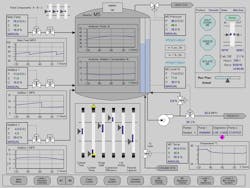The trend toward greater use of high-performance HMI screens, which are less brightly colored overall to help highlight the alarms of highest consequence, has been gaining a lot of traction over the past few years. Helping drive the adoption of these less-than-colorful screens are studies from groups such as the Abnormal Situation Management Consortium which indicate that high-performance HMI screens can help operators notice alarm situations faster and react to them more appropriately.
But not everyone is onboard with this new trend. Several comments posted on various social media group discussions around my article “HMIs at an Inflection Point?” noted that the gray high-performance HMI screens are “boring” and can cause operators to get “sleepy” after viewing them for several hours.
Another hurdle for high-performance HMI could come from the next generation of manufacturing workers who have spent their lives interacting with consumer computer technologies. Even some experienced manufacturing workers are not enamored of the high-performance HMI trend because of the difference in experience compared to consumer technologies.
As Mike Korkowski, a controls engineer with Haumiller Engineering in Elgin, Ill., pointed out in a message to me after reading my “Engineers Agree to Disagree on HMI Direction” blog: “It disturbs me to continuously deal with this ‘gray’ thing. I find this [trend] annoying and it has picked up a bit. The performance of the screen is not the issue. The issue is color. In the PC world, gray means off; gray means no; gray means unavailable; gray means do not use. Yet I see certain software packages with a button that is grayed out and it needs to be selected.”
Korkowski noted that he prefers a more colorful screen with animation as required, but minimized. “My company uses light blue and other blues which seems to work,” he said.
Despite the clear and quantified value of high-performance HMI screens, the jury still seems to be out on this issue among HMI users. HMI purchasing and implementation decisions made over the next few years will likely determine if the future of manufacturing will be filled with gray high-performance HMI screens or if some middle ground between the two extremes will emerge as the industry’s preference.
Leaders relevant to this article:


